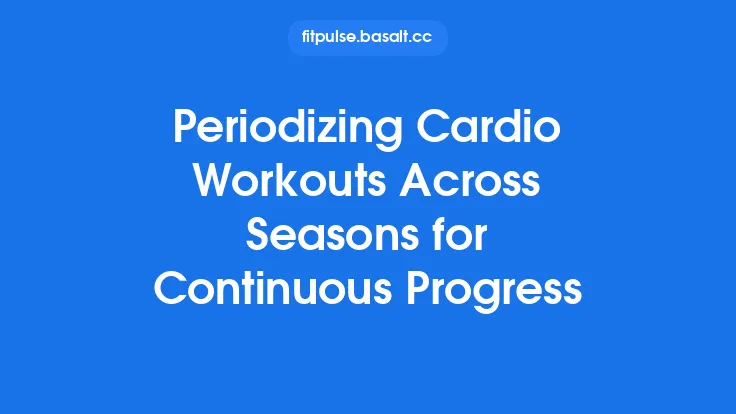Low‑impact aerobic exercise is a cornerstone of joint‑preserving activity for people living with arthritis. By moving the body in a controlled, rhythmic manner that minimizes compressive forces on the joints, individuals can reap cardiovascular, metabolic, and psychosocial benefits while protecting the very structures that are most vulnerable to wear and inflammation. This article delves into the science behind low‑impact aerobic workouts, outlines practical guidelines for creating safe and effective sessions, and provides concrete examples that can be adapted to a wide range of arthritis presentations.
Understanding Arthritis and Joint Health
Arthritis is an umbrella term that encompasses more than 100 distinct conditions, the most common being osteoarthritis (OA) and rheumatoid arthritis (RA). Although the underlying pathophysiology differs—mechanical cartilage degeneration in OA versus autoimmune synovial inflammation in RA—the end result is often pain, stiffness, reduced range of motion, and functional limitation.
Key concepts for exercise prescription in this population include:
| Concept | Relevance to Exercise |
|---|---|
| Joint Load | The magnitude of force transmitted across a joint during movement. Excessive load can accelerate cartilage wear or exacerbate synovial inflammation. |
| Range of Motion (ROM) | Maintaining or gently improving ROM helps prevent contractures and preserves functional mobility. |
| Inflammatory State | Acute flares may increase pain sensitivity; exercise intensity should be modulated accordingly. |
| Muscle Strength | Strong peri‑articular muscles act as shock absorbers, reducing joint stress. |
| Proprioception | Accurate joint position sense supports safe movement patterns and reduces injury risk. |
Low‑impact aerobic activity is uniquely suited to address these variables because it promotes movement without the high ground‑reaction forces seen in running, jumping, or high‑intensity interval training.
Benefits of Low‑Impact Aerobic Exercise
- Cardiovascular Conditioning – Improves VO₂max and reduces cardiovascular disease risk, which is elevated in many arthritis cohorts.
- Weight Management – Helps achieve or maintain a healthy body mass index (BMI), decreasing mechanical load on weight‑bearing joints.
- Pain Modulation – Endorphin release and improved circulation can attenuate pain perception.
- Joint Lubrication – Repetitive, low‑force motion stimulates synovial fluid production, enhancing cartilage nutrition.
- Inflammation Control – Regular aerobic activity has been shown to lower systemic inflammatory markers (e.g., C‑reactive protein).
- Psychological Well‑Being – Reduces symptoms of anxiety and depression, which are common comorbidities in chronic joint disease.
Key Principles for Designing Low‑Impact Workouts
| Principle | Practical Application |
|---|---|
| Gradual Progression | Start with 5–10 minutes of activity, 2–3 times per week, and increase duration by ~10 % each week. |
| Intensity Monitoring | Use the Rating of Perceived Exertion (RPE) scale (target 11–13 “light to somewhat hard”) or heart‑rate reserve (40–60 % of HRR). |
| Pain‑First Rule | Exercise should not exacerbate joint pain beyond a mild, transient level (≤2/10 on a numeric pain scale). |
| Joint‑Specific Modifications | For knee OA, limit deep flexion (<90°); for hand RA, avoid gripping heavy handlebars. |
| Consistency Over Intensity | Regular, moderate sessions are more beneficial than sporadic high‑intensity bouts. |
| Incorporate Rest | Include at least one full rest day per week and inter‑set recovery periods of 30–60 seconds. |
Types of Low‑Impact Aerobic Activities
| Activity | Joint Load Characteristics | Typical Session Structure |
|---|---|---|
| Brisk Walking | Ground‑reaction forces ≈ 1.2 × body weight; minimal impact if stride is short and cadence is steady. | 5‑min warm‑up, 20‑30 min steady walk, 5‑min cool‑down. |
| Stationary Cycling | Load confined to the hip and knee; pedal resistance can be adjusted to keep joint torque low. | 5‑min low‑resistance warm‑up, 20‑40 min moderate resistance, 5‑min easy spin. |
| Elliptical Trainer | Simultaneous gliding motion reduces peak joint forces; handles provide upper‑body support. | 5‑min low‑resistance warm‑up, 15‑30 min moderate resistance, 5‑min cool‑down. |
| Water Walking/Aquatic Jogging | Buoyancy reduces effective body weight by 30‑70 %; water resistance provides gentle overload. | 5‑min water acclimation, 20‑30 min continuous walking/jogging, 5‑min floating stretch. |
| Seated Cardio (e.g., chair marching, seated boxing) | No weight‑bearing; joint stress limited to upper extremities and core. | 5‑min seated warm‑up, 15‑25 min rhythmic movements, 5‑min seated cool‑down. |
| Recumbent Stepper | Low‑impact stepping motion with back support; distributes load across hips and knees. | 5‑min low‑resistance warm‑up, 20‑30 min moderate resistance, 5‑min cool‑down. |
Tip: Choose activities that the individual enjoys and can perform safely in their home or community environment. Variety helps maintain motivation and reduces overuse of any single joint.
Structuring a Session
- Warm‑Up (5–10 min)
- Light aerobic movement (e.g., slow walking, gentle cycling).
- Dynamic joint mobilizations: ankle circles, hip swings, shoulder rolls.
- Goal: raise core temperature by ~1 °C and increase synovial fluid circulation.
- Main Set (15–40 min)
- Maintain target intensity (RPE 11–13 or 40–60 % HRR).
- Use interval formats if needed: 2 min moderate, 1 min easy, repeat.
- Monitor pain and adjust speed or resistance accordingly.
- Cool‑Down (5–10 min)
- Gradual reduction of intensity to bring heart rate down.
- Static stretching of major muscle groups (quadriceps, hamstrings, calves, chest, back).
- Deep breathing to promote parasympathetic activation.
- Post‑Session Evaluation
- Record pain level, RPE, duration, and any joint swelling.
- Use a simple logbook or digital app for tracking trends over weeks.
Progression and Monitoring
| Variable | How to Progress | Monitoring Tool |
|---|---|---|
| Duration | Add 2–5 minutes per session once the current duration feels easy. | Session log (total minutes). |
| Frequency | Increase from 2 to 3 sessions per week after 4–6 weeks of consistency. | Calendar tracking. |
| Intensity | Slightly raise resistance or speed while keeping RPE ≤13. | Heart‑rate monitor or RPE scale. |
| Complexity | Introduce mild directional changes (e.g., side steps) to challenge proprioception. | Observation of gait and balance. |
| Pain | If pain >2/10 persists for >24 h, reduce load or revert to previous level. | Numeric Pain Rating Scale (NPRS). |
Regular reassessment (every 4–6 weeks) with a qualified health professional ensures that progression remains safe and aligned with disease status.
Safety Considerations and Contra‑Indications
- Acute Flare‑Ups: During periods of heightened joint inflammation, prioritize gentle range‑of‑motion exercises and postpone higher‑intensity aerobic work.
- Joint Instability: Use supportive devices (e.g., knee brace) if needed, and avoid activities that require rapid directional changes.
- Comorbid Cardiovascular Issues: Obtain medical clearance before initiating any new aerobic program; start at the lower end of the intensity spectrum.
- Footwear: Choose shoes with adequate cushioning, arch support, and a wide toe box to reduce forefoot pressure.
- Environment: Ensure a non‑slippery surface, adequate lighting, and temperature control to prevent falls and overheating.
Integrating Strength and Flexibility
While the focus of this article is aerobic work, pairing low‑impact cardio with light resistance training (1–2 sessions per week) amplifies joint protection. Targeted exercises such as seated leg extensions, wall squats, and theraband shoulder rotations improve muscular support without adding excessive joint stress. Flexibility work—especially gentle static stretching after the aerobic cool‑down—maintains joint capsule elasticity and reduces stiffness.
Equipment and Environment Recommendations
| Item | Rationale |
|---|---|
| Non‑Slip Exercise Mat | Provides stable footing for indoor walking or seated cardio. |
| Adjustable Resistance Bands | Offer progressive overload for upper‑body conditioning without weight‑bearing. |
| Water‑Resistant Shoes | Useful for poolside walking; prevents slipping on wet surfaces. |
| Heart‑Rate Monitor | Facilitates objective intensity tracking, especially for those on beta‑blockers. |
| Portable Pedal Exerciser | Enables seated aerobic work for individuals with limited mobility. |
| Climate‑Controlled Space | Prevents overheating, which can exacerbate joint pain. |
Sample Weekly Program (4 Weeks)
| Day | Activity | Duration | Intensity (RPE) | Notes |
|---|---|---|---|---|
| Mon | Brisk walking (outdoor or treadmill) | 20 min | 11 | Warm‑up 5 min, walk 10 min, cool‑down 5 min |
| Tue | Rest or gentle stretching | — | — | Focus on hip and shoulder mobility |
| Wed | Stationary cycling | 25 min | 12 | Keep cadence 60–70 rpm, low resistance |
| Thu | Seated cardio (chair marching + arm circles) | 20 min | 11 | Use a TV for guided routine |
| Fri | Water walking (pool) | 30 min | 12 | Use a flotation belt if needed |
| Sat | Light resistance circuit (bands) + walking | 15 min cardio + 10 min strength | 11 | Emphasize quadriceps and scapular stabilizers |
| Sun | Rest | — | — | Optional gentle yoga for flexibility |
Progression: Increase each session by 5 minutes after week 2, and add a second cardio day in week 4 if pain remains ≤2/10.
Frequently Asked Questions
Q: Can I do high‑intensity interval training (HIIT) if I have arthritis?
A: HIIT can be adapted to low‑impact modalities (e.g., elliptical intervals) but should only be attempted after a solid aerobic base (≥150 min/week of moderate activity) and with medical clearance. Keep intervals short (30 seconds) and recovery periods longer (90 seconds) to avoid excessive joint loading.
Q: How do I know if my joint pain is from exercise or disease activity?
A: Exercise‑related discomfort typically resolves within 24 hours and is proportional to the session’s intensity. Pain that persists, worsens, or is accompanied by swelling suggests a disease flare and warrants a pause in activity and consultation with a rheumatologist.
Q: Is it safe to exercise on a treadmill with a walking aid?
A: Yes, provided the treadmill speed is set low (≤2 mph) and the handrail is used for balance. Start with short bouts (5 minutes) and gradually increase as confidence improves.
Q: Should I wear a brace during aerobic workouts?
A: A well‑fitted brace can provide proprioceptive feedback and reduce pain for unstable joints. However, it should not restrict normal range of motion; a physical therapist can help select the appropriate type.
Closing Thoughts
Low‑impact aerobic workouts offer a sustainable, joint‑friendly pathway to improve cardiovascular health, manage weight, and alleviate pain for individuals living with arthritis. By adhering to the principles of gradual progression, pain‑first monitoring, and individualized modification, patients can safely incorporate regular aerobic activity into their daily routine. Coupled with modest strength work and flexibility training, these exercises form a comprehensive, evidence‑based strategy that supports long‑term joint health and overall quality of life.





